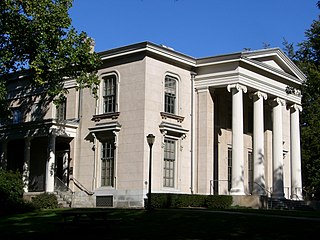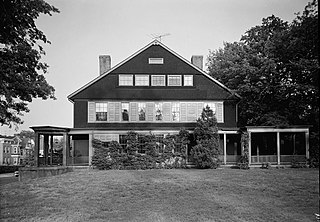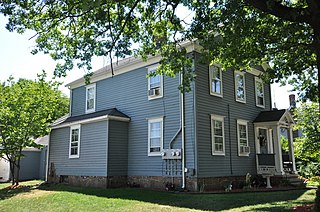
The New Haven Green is a 16-acre (65,000 m2) privately owned park and recreation area located in the downtown district of the city of New Haven, Connecticut, United States. It comprises the central square of the nine-square settlement plan of the original Puritan colonists in New Haven, and was designed and surveyed by colonist John Brockett. Today the Green is bordered by the modern paved roads of College, Chapel, Church, and Elm streets. Temple Street bisects the Green into upper (northwest) and lower (southeast) halves.

Hillhouse Avenue is a street in New Haven, Connecticut, famous for its many nineteenth century mansions, including the president's house at Yale University. Both Charles Dickens and Mark Twain have described it as "the most beautiful street in America." Much of the avenue is included in the Hillhouse Avenue Historic District, which extends to include houses on adjacent streets.

Cedar Hill is a neighborhood in New Haven, Connecticut. It includes portions of the city-designated neighborhoods of East Rock, Quinnipiac Meadows, and Mill River. Cedar Hill was named for cedar trees that were once plentiful there in 1665. The area was divided from the local surroundings by the construction of I-91 in the 1960s. Cedar Hill's boundary runs from James Street, up the Mill River, to Rice Field, over Indian Head Rock, to the Hamden town line, across to Middletown Avenue, to the Eastern side of State Street, back up to James Street.

David Hoadley was an American architect who worked in New Haven and Middlesex counties in Connecticut.

The Whitney Avenue Historic District is a historic district in the East Rock neighborhood of New Haven, Connecticut. It is a 203-acre (82 ha) district which included 1,084 contributing buildings when it was listed on the National Register of Historic Places in 1989.

Norwichtown is a historic neighborhood in the city of Norwich, Connecticut. It is generally the area immediately north of the Yantic River between I-395 and Route 169.
Babb, Cook & Willard was a New York City-based architectural firm established in 1884 that designed many important houses and commercial buildings. The principals of the firm were George Fletcher Babb (1836–1915), Walter Cook (1843–1916), and Daniel W. Willard. Willard left the firm in 1908, and was replaced by Winthrop A. Welch. The firm was subsequently renamed Babb, Cook and Welch until 1912, when it became Cook and Welch.

The Atwater–Ciampolini House, also known as the Charles Atwater House, is located at 321 Whitney Avenue in New Haven, Connecticut, at the southwest corner of intersection with Edwards Street. It is an important example of Shingle style architecture. It was designed by New York City-based architects Babb, Cook and Willard and was built during 1890-92. For many years the property had served as offices for Thompson and Peck, an insurance agency.

The Caroline Nicoll House is a historic house at 27 Elm Street in New Haven, Connecticut, USA. Built in 1828, it is a rare surviving example of an urban townhouse from that period, and a well-preserved example of transitional Federal-Greek Revival architecture. The house was listed on the National Register of Historic Places in 1983.

The William Pinto House, also known as William Pinto-Eli Whitney House, is a historic house at 275 Orange Street in New Haven, Connecticut. It is a Federal-style building of post-and-beam construction, and was built in 1810 for John Cook, a merchant. It is rare and unusual for its design, which places the gable end facing the street, rather than to the side as was more typical in the Federal period. It is historically notable for its second owner, William Pinto, a member of one of New Haven's leading Jewish families, and for its third occupant, Eli Whitney, who leased the house from Pinto in the later years of his life. The house was listed on the National Register of Historic Places in 1985. It now houses professional offices.

The Kraus Corset Factory is a historic industrial property at 33 Roosevelt Drive in Derby, Connecticut. The oldest portion of the large brick building, built in 1879, faces Third Street, while a c. 1910 addition extends along Roosevelt Drive. It is the only major building to survive from Derby's period of corset manufacturing. It was built by Sidney Downs, one of Derby's leading businessmen of the period. The building was listed on the National Register of Historic Places on February 12, 1987. It has been converted into apartments.

Sidney Mason Stone was a prominent Connecticut architect and builder known for designs of churches, institutional buildings and residences. His creations incorporated Greek Revival, Romanesque, Gothic, Italianate and other styles popular in the 19th century. He served in several civic capacities in the city of New Haven and statewide and as mentor to Yale students prior to the establishment of that university's School of Architecture. He was the father of Harriet Mulford Stone, better known to readers of children's literature as Margaret Sidney, creator of the Five Little Peppers series.

The Simeon Smith House is a historic house on Main Road in West Haven, Vermont. Built in 1798–1800 to a design by William Sprat, a prominent housewright from Litchfield, Connecticut, it is a fine example of period Federal architecture. It was built for Simeon Smith, a wealthy businessman who moved here from Connecticut. The house was listed on the National Register of Historic Places in 1983.

The Samuel Paddock Strong House is a historic house at 94 West Main Street in Vergennes, Vermont. Built in the 1830s for a prominent local businessman, it is a well-preserved example of Greek Revival architecture. It was listed on the National Register of Historic Places in 1979. It now houses the Strong House Inn.

The Governor Smith Homestead is a historic house on South Main Street in Sharon, Connecticut. Built between 1765 and 1777, this large stone house has been a distinctive presence on the Sharon Green for over 200 years. It was for many years the home of John Cotton Smith, Governor of Connecticut during the War of 1812, and a nephew of the house's builder, Simeon Smith. The house was listed on the National Register of Historic Places in 1982, and was included in the Sharon Historic District in 1993.

The George Atwater House is a historic house at 1845 State Street in Hamden, Connecticut. Built about 1820, it is a good local example of a vernacular Federal period farmhouse, with a well-preserved interior and unusual floorplan. It was listed on the National Register of Historic Places in 1992.

The Atwater-Linton House, also known historically as Appledore, is a historic house at 1804 State Street in Hamden, Connecticut. Built about 1781 by a descendant of one of the area's first settlers, it was the home of engraver and political activist William James Linton in the late 19th century. It was listed on the National Register of Historic Places in 1992.

The John Hoadley House is a historic house at 213 Leete's Island Road in Branford, Connecticut. Built about 1810, it is a well-preserved example of late colonial architecture. It was listed on the National Register of Historic Places in 1988.

The Route 146 Historic District encompasses a historic streetscape in Branford and Guilford, Connecticut. Extending along Connecticut Route 146 between Flat Rock Road in Branford and the West River bridge in Guilford, it includes two centuries of rural residential architecture, and a well-preserved pre-World War II street layout created as a "state assistance road" in the 1920s. The district was listed on the National Register of Historic Places in 1990.

The Wheeler-Beecher House is a historic house at 562 Amity Road in Bethany, Connecticut. Built in 1807, it is a good example of Federal period architecture, designed by New Haven architect David Hoadley. The house was listed on the National Register of Historic Places in 1977.





















